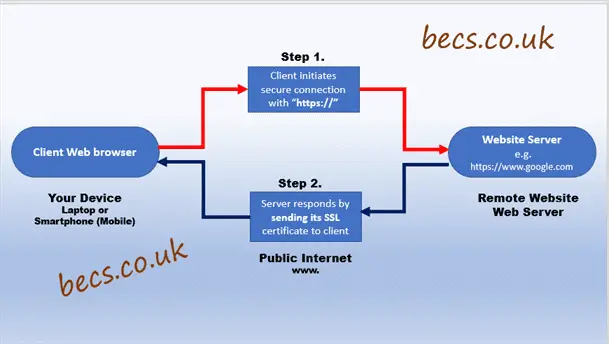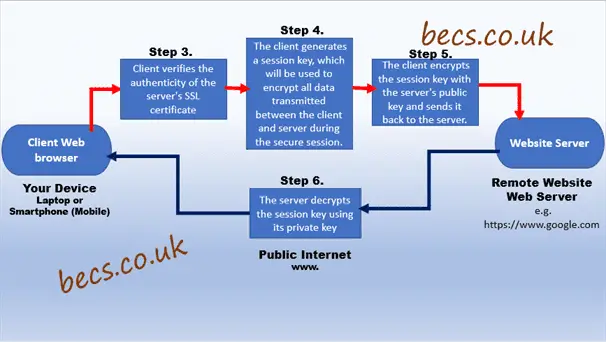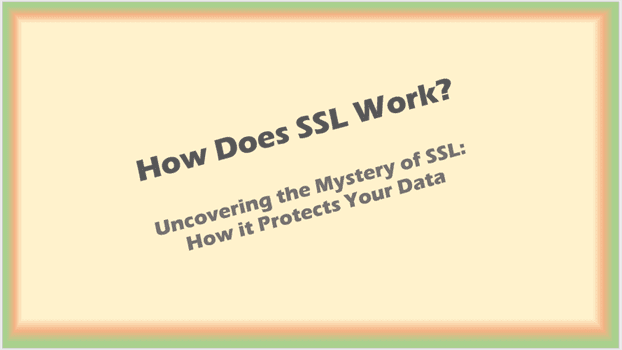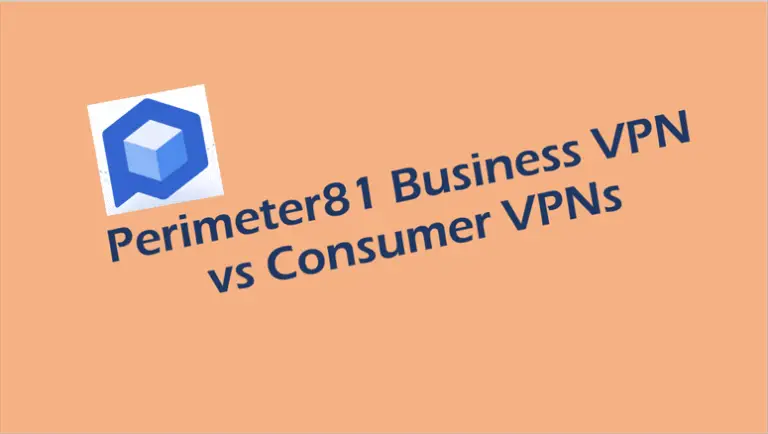How Does SSL Work (An Illustrated Guide)
Welcome, IT Professionals or enthusiasts, to this informative blog post on “How Does SSL Work”.
In today’s digital age, online security has become a critical concern for businesses and individuals alike. One of the most important tools in securing online communication is SSL. But what is SSL, and how does it work?
In this blog post, we will explore SSL in detail, covering everything from what SSL is, how it works between clients and servers, in browsers, and even on platforms like Reddit and Stack Overflow. We’ll also dive into the SSL handshake process, how SSL works with load balancers, and on which layer SSL operates.
By the end of this blog post, you’ll have a comprehensive understanding of how SSL works, and how it plays a crucial role in securing online communication. So, let’s get started and dive into the world of SSL!
I. How does SSL work – Introduction
SSL, or Secure Sockets Layer, is a critical tool for securing online communication. It allows for the secure transfer of data between a client and a server, preventing unauthorized access and ensuring privacy.
As an IT enthusiast, you likely understand the importance of online security, and SSL is one of the most essential tools in this regard. It is used by millions of websites worldwide to encrypt sensitive information, such as login credentials, credit card details, and personal data.
In this blog post, we will explore SSL in detail and answer the question, “How does SSL work?” We will cover everything from the basics of SSL to the intricate details of the SSL handshake process. We’ll also delve into how SSL works between clients and servers, in browsers, on platforms like Reddit and Stack Overflow, and with load balancers.
By the end of this post, you’ll have a comprehensive understanding of SSL and how it plays a crucial role in securing online communication. So, let’s dive into the world of SSL and explore its inner workings together.
II. What is SSL?
Assuming you’re an IT professional or enthusiast, you may be familiar with SSL, but it’s always good to start with the basics. What does SSL stand for? SSL, or Secure Sockets Layer, is a protocol that provides secure communication over the internet. It ensures that the data transmitted between a client and a server is encrypted and remains private.
The purpose of SSL is to prevent unauthorized access to sensitive information, such as login credentials, credit card details, and personal data. SSL works by creating a secure connection between a client and a server using encryption. This means that any information transmitted between them is unreadable to anyone who intercepts it.
SSL certificates play a crucial role in securing online communication. They are digital certificates that verify the identity of the website or server you are communicating with. When a website has an SSL certificate, you can be confident that you are communicating with the right website and that your data is encrypted and secure.
To conclude this section “What is SSL?”, SSL is a protocol that provides secure communication over the internet by encrypting data transmission between a client and a server. SSL certificates play a crucial role in verifying the identity of websites and servers and ensuring that online communication is secure.
III. SSL vs TLS
As an IT person, you may have heard the terms SSL and TLS being used interchangeably, but they are not the same thing. SSL, or Secure Sockets Layer, was the original protocol developed to provide secure communication over the internet. TLS, or Transport Layer Security, is the newer and more secure protocol that succeeded SSL.
One of the main differences between SSL and TLS is the strength of their encryption. TLS uses stronger encryption algorithms and offers better protection against attacks than SSL. Additionally, SSL has vulnerabilities that have been discovered over time, making it less secure than TLS.
TLS is essential in securing online communication, just like SSL. It is used by millions of websites worldwide to encrypt sensitive information and prevent unauthorized access. The most common use of TLS is in HTTPS, the secure version of HTTP, which is used to transmit data over the internet.
Summarizing this section “SSL vs TLS”, TLS is the more secure protocol that succeeded SSL. It offers stronger encryption and better protection against attacks, making it essential in securing online communication. TLS is commonly used in HTTPS, which is used by millions of websites worldwide to encrypt sensitive information and ensure the privacy of their users.
IV. How SSL works between client and server?
As an IT enthusiast, you may wonder how SSL works between a client and a server. The answer lies in the SSL handshake process, which is a series of steps that establish a secure connection between them.

The SSL handshake process begins when a client sends a request to a server that is secured with SSL. The server responds by sending its SSL certificate to the client, which includes a public key that the client can use to encrypt its data.
The client then verifies the authenticity of the server’s SSL certificate and creates a random session key, which it encrypts with the server’s public key and sends back to the server. The server decrypts the session key using its private key and sends an acknowledgement to the client.
At this point, both the client and the server have the same session key, which they can use to encrypt and decrypt data. All communication between them is encrypted using this session key, ensuring that any data transmitted between them remains private and secure.
The SSL handshake process is a series of steps that establish a secure connection between a client and a server. The client verifies the server’s SSL certificate, creates a random session key, and sends it to the server. The server then uses its private key to decrypt the session key, and both the client and server can use it to encrypt and decrypt data, ensuring that the communication between them is secure.
V. How SSL Work in a Browser?
As an IT enthusiast, you likely use a web browser every day to access websites and communicate online. But have you ever wondered how SSL works in a browser to secure your online communication?
SSL is used in browsers to provide a secure connection between the client (your browser) and the server (the website you are accessing). This is done through HTTPS, which is the secure version of HTTP.
When you visit a website using HTTPS, your browser sends a request to the server, and the server responds by sending its SSL certificate to your browser. Your browser then verifies the authenticity of the SSL certificate and creates a secure connection with the server.
All data transmitted between your browser and the server is encrypted using SSL, ensuring that any sensitive information, such as login credentials, credit card details, and personal data, is secure and cannot be intercepted by unauthorized parties.
SSL certificates play a critical role in securing online communication in a browser. They verify the identity of the website or server you are communicating with, ensuring that you are not communicating with a fake or malicious website. SSL certificates are issued by trusted Certificate Authorities (CAs), which have been authorized to issue SSL certificates and verify the identity of websites and servers.
In summary to this section “How SSL works in browser”, SSL works in a browser by creating a secure connection between the client (your browser) and the server (the website you are accessing) through HTTPS. All data transmitted between your browser and the server is encrypted using SSL, and SSL certificates play a crucial role in verifying the identity of websites and servers and ensuring that online communication is secure.
VI. How SSL Works in HTTPS?
If you’re in IT, you may be familiar with HTTPS, which is the secure version of HTTP used to transmit data over the internet. But how does SSL work in HTTPS to secure online communication?

SSL is used in HTTPS to provide a secure connection between the client (your browser) and the server (the website you are accessing). The SSL handshake process is used to establish this secure connection.
The SSL handshake process in HTTPS involves several steps. It begins when your browser sends a request to a server that is secured with SSL. The server responds by sending its SSL certificate to your browser, which includes a public key that your browser can use to encrypt its data.
Your browser then verifies the authenticity of the server’s SSL certificate and creates a random session key, which it encrypts with the server’s public key and sends back to the server. The server decrypts the session key using its private key and sends an acknowledgement to your browser.
Once the SSL handshake is complete, your browser and the server have the same session key, which they can use to encrypt and decrypt data. All communication between your browser and the server is encrypted using this session key, ensuring that any data transmitted between them remains private and secure.
To summarize this section on “How Does SSL Work in HTTPS?”, SSL works in HTTPS by establishing a secure connection between the client (your browser) and the server (the website you are accessing) through the SSL handshake process. The SSL handshake involves several steps, and once complete, your browser and the server have a session key that they can use to encrypt and decrypt data, ensuring that online communication is secure.
VII. How Does SSL Handshake Works Step by Step?
As an IT professional or enthusiast, you may be interested in the intricate details of the SSL handshake process. This process is used to establish a secure connection between a client and a server, and it involves several steps.
Step 1: Client Hello
The client sends a “hello” message to the server, which includes the version of SSL/TLS it is using, a random number, and the encryption algorithms it supports.
Step 2: Server Hello
The server responds with its own “hello” message, which includes the version of SSL/TLS it is using, a random number, and the encryption algorithm it will use.
Step 3: SSL Certificate
The server sends its SSL certificate to the client, which includes a public key that the client can use to encrypt its data.
Step 4: Client Key Exchange
The client creates a random session key and encrypts it with the server’s public key. The encrypted session key is sent back to the server.
Step 5: SSL Certificate Verify
The server verifies the authenticity of its SSL certificate and sends a message to the client to confirm.
Step 6: Change Cipher Spec
Both the client and server send a message to each other to indicate that they will be using the encryption algorithm agreed upon in the handshake process.
Step 7: Encrypted Handshake Message
The client and server exchange encrypted messages to confirm that the SSL handshake is complete, and secure communication can begin.

During the SSL handshake process, SSL works to secure online communication by ensuring that all data transmitted between the client and server is encrypted and cannot be intercepted by unauthorized parties.
In summary, the SSL handshake process is a series of steps used to establish a secure connection between a client and a server. The process involves several steps, including client hello, server hello, SSL certificate exchange, client key exchange, SSL certificate verification, change cipher spec, and encrypted handshake message exchange. SSL works to secure online communication during the handshake process by ensuring that all data transmitted between the client and server is encrypted and cannot be intercepted.
VIII. How Does SSL Work Between Two Servers?
As an IT enthusiast, you may be interested in understanding how SSL works between two servers. SSL can be used to secure communication between servers, just like it can be used between clients and servers.
SSL works between servers using a similar process to the SSL handshake between clients and servers. When two servers communicate with each other over SSL, they follow a series of steps to establish a secure connection.
The SSL handshake process between servers involves several steps, including a client hello, server hello, SSL certificate exchange, client key exchange, SSL certificate verification, change cipher spec, and encrypted handshake message exchange.
During the SSL handshake, the two servers agree upon a session key that they will use to encrypt and decrypt data during their communication. All data transmitted between the two servers is encrypted using this session key, ensuring that any sensitive information remains private and secure.
SSL is essential in securing online communication between servers. It ensures that any data transmitted between them cannot be intercepted by unauthorized parties and remains private.
To summarize this section “How Does SSL Work Between Two Servers?”, SSL works between two servers using a similar process to the SSL handshake between clients and servers. The SSL handshake process establishes a secure connection between the servers, and all data transmitted between them is encrypted using a session key agreed upon during the handshake. SSL is crucial in securing online communication between servers and ensuring the privacy of any sensitive information transmitted between them.
IX. How Does SSL Work with a Load Balancer?
As an IT person, you may be familiar with load balancers, which distribute network traffic across multiple servers to improve performance and ensure high availability. But have you ever wondered how SSL works with a load balancer to secure online communication?
SSL works with a load balancer by encrypting data between the client and the load balancer and then decrypting it between the load balancer and the server. This ensures that the communication between the client and server is secure, even though multiple servers may be involved.
The SSL handshake process with a load balancer is similar to the SSL handshake between a client and server. The client sends a request to the load balancer, which forwards the request to the appropriate server. The server responds with its SSL certificate, and the load balancer verifies its authenticity.
The load balancer then creates a new SSL connection to the client, using its own SSL certificate. All communication between the client and load balancer is encrypted using this SSL connection. The load balancer then creates a new SSL connection to the server, using the server’s SSL certificate. All communication between the load balancer and server is encrypted using this SSL connection.
SSL is essential in securing online communication with a load balancer. It ensures that any sensitive information transmitted between the client and server remains private and cannot be intercepted by unauthorized parties.
In summary, SSL works with a load balancer by encrypting data between the client and load balancer and between the load balancer and server. The SSL handshake process with a load balancer is similar to the SSL handshake between a client and server. SSL is crucial in securing online communication with a load balancer and ensuring the privacy of any sensitive information transmitted between the client and server.
X. How Does SSL Work on Reddit and Stack Overflow?
If you’re an IT enthusiast, you may use Reddit and Stack Overflow for information and discussions related to IT. But have you ever wondered how SSL works on these platforms to secure your online communication?
SSL works on Reddit and Stack Overflow by providing a secure connection between your browser and their servers. This ensures that any sensitive information, such as login credentials and personal data, remains private and cannot be intercepted by unauthorized parties.
The SSL handshake process on these platforms involves several steps. When you access Reddit or Stack Overflow using HTTPS, your browser sends a request to their servers. The server responds with its SSL certificate, which includes a public key that your browser can use to encrypt its data.
Your browser then verifies the authenticity of the SSL certificate and creates a secure connection with the server. All data transmitted between your browser and the server is encrypted using SSL, ensuring that it remains private and secure.
SSL is essential in securing online communication on Reddit and Stack Overflow. It ensures that any sensitive information transmitted between your browser and their servers remains private and cannot be intercepted by unauthorized parties.
To end this section of the article, SSL works on Reddit and Stack Overflow by providing a secure connection between your browser and their servers through HTTPS. The SSL handshake process involves several steps, and all data transmitted between your browser and their servers is encrypted using SSL. SSL is crucial in securing online communication on these platforms and ensuring the privacy of any sensitive information transmitted between your browser and their servers.
XI. How Does SSL Work Diagram
You may find it helpful to see a visual representation of how SSL works. A diagram can help to simplify the complex process of the SSL handshake and show the different steps involved.



how does SSL work step by step
Here’s a detailed explanation of how SSL (Secure Sockets Layer) works in response to the question “How does SSL work step by step”
- Client initiates a secure connection with the server by sending a request to the server.
- The server responds by sending its SSL certificate to the client. The SSL certificate contains the public key of the server, which the client will use to encrypt data during the secure session.
- The client verifies the authenticity of the server’s SSL certificate. This involves checking that the certificate was issued by a trusted Certificate Authority (CA) and that it has not expired or been revoked.
- The client generates a session key, which will be used to encrypt all data transmitted between the client and server during the secure session.
- The client encrypts the session key with the server’s public key and sends it back to the server.
- The server decrypts the session key using its private key.
- The client and server exchange encrypted data using the session key, ensuring that all data transmitted between them is secure and cannot be intercepted by unauthorized parties.
Throughout the SSL handshake process, both the client and server work together to establish a secure connection and ensure that all data transmitted between them is encrypted and secure. This process is crucial for protecting sensitive information, such as login credentials, personal information, and financial information, during online communication.
XII. SSL Works on Which Layer?
If you’re an IT professional, you may be familiar with the different layers of the network stack, which are used to organize and transmit data across a network. But do you know where SSL fits into this stack (the OSI model)?
SSL protocol works in the transport layer of the network stack. The transport layer is responsible for ensuring reliable data transmission across a network and providing end-to-end error recovery and flow control. The transport layer is also responsible for establishing and terminating connections between applications.
SSL works in the transport layer by providing a secure, encrypted connection between a client and server. SSL is responsible for establishing and maintaining this secure connection and ensuring that any data transmitted between the client and server remains private and secure.

SSL works by adding a security layer on top of the transport layer protocol, such as TCP or UDP. When SSL is used, all data transmitted between the client and server is encrypted using SSL, ensuring that it cannot be intercepted by unauthorized parties.
To summarize, SSL works in the transport layer of the network stack, providing a secure, encrypted connection between a client and server. It works by adding a security layer on top of the transport layer protocol, ensuring that any data transmitted between the client and server remains private and secure.
XIII. Conclusion – How does SSL work?
Whether you’re an IT professional or just an enthusiast, you’ve learned a lot about how SSL works and its importance in securing online communication. Let’s recap what we covered in this article:
- We defined SSL and its purpose in securing online communication.
- We explained the differences between SSL and TLS and the importance of TLS in securing online communication.
- We discussed how SSL works between a client and server, including the SSL handshake process.
- We explained how SSL works in a browser and in HTTPS, including the steps involved in the SSL handshake.
- We described how SSL works between two servers and with a load balancer.
- We explained how SSL works on Reddit and Stack Overflow.
- We provided a visual representation of how SSL works using a diagram.
- We explained that SSL works in the transport layer of the network stack.
It’s clear that SSL is crucial in securing online communication. Without SSL, any data transmitted between a client and server is vulnerable to interception by unauthorized parties. SSL provides a secure, encrypted connection that ensures the privacy of any sensitive information transmitted online.
In conclusion, we hope that this article has helped you understand how SSL works and why it’s essential in securing online communication. By implementing SSL, you can ensure that your online communication remains private and secure.
Related Posts:
Further Reading:






